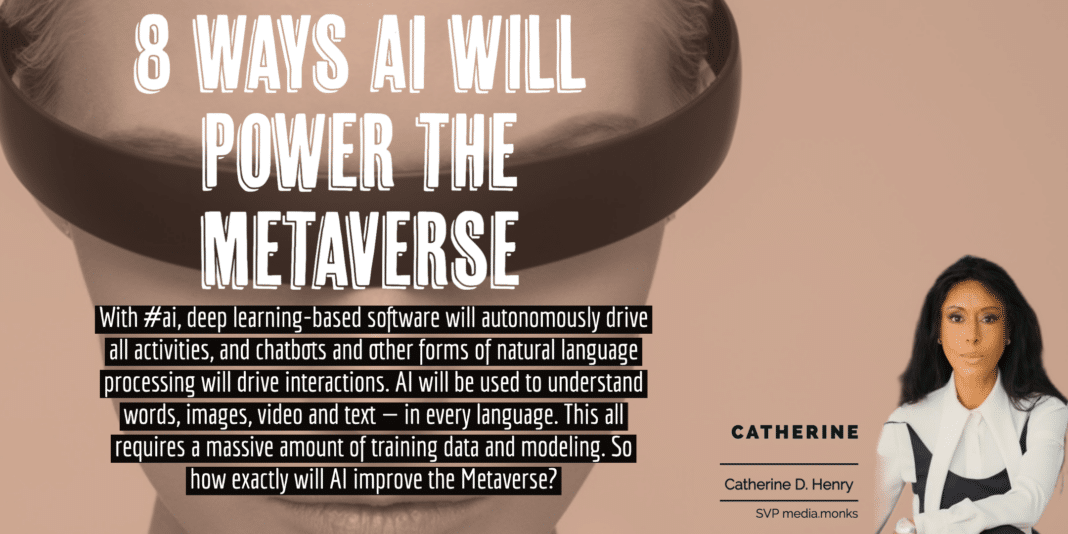Ways AI will power the #Metaverse. With #ai, deep learning-based software will autonomously drive all activities, and chatbots and other forms of natural language processing will drive interactions. AI will be used to understand words, images, video and text — in every language. This all requires a massive amount of training data and modeling. So how exactly will AI improve the Metaverse?

1. AI-powered operations (AIOps) You know what’s not a good time? When your platform is down. That’s why we’re so excited about AI-powered operations (AIOps). AIOps can be used to predict and prevent outages, identify problems in real time, and optimize resources. That way your platform stays robust, always on, and scalable—so you don’t have to spend all your time worrying about when the next outage will happen or how to prevent it.
2. AI bots can be used for a variety of tasks, including customer service, marketing, and sales and monitor in-world activity, like prevent abuse and hate speech by identifying and flagging potentially harmful or inappropriate content. This is particularly useful in online gaming and social media platforms where abuse and hate speech can be prevalent. AI bots can scan text and speech, as well as identify visual content, to detect instances of harassment, bullying, hate speech, and other forms of abusive behavior. They can then either remove the content or alert human moderators to take action, helping to create a safer and more positive online environment. This type of monitoring and enforcement can help prevent toxic behavior and promote healthy community interactions. Additionally, AI bots can also be used to monitor in-world activity for potential security breaches, such as hacking and cheating, ensuring that virtual environments remain fair and secure for all users.
3. Avatars: AI can help generate realistic avatars and use natural language processing to create realistic dialogue. Avatars are digital representations of individuals in virtual environments. With the advancement of AI technology, it is now possible to generate realistic avatars that closely resemble their human counterparts. These avatars can be customized with various physical and clothing attributes, allowing individuals to create unique and personalized digital representations of themselves. Furthermore, AI can also be used to generate natural-looking movements and gestures for avatars, making them appear more lifelike and interactive in virtual environments.
Another way AI can help with avatars is through natural language processing (NLP). NLP allows AI systems to understand and respond to human language in a more human-like manner. This means that avatars can have more realistic and engaging conversations with human users, using language that sounds natural and intuitive. NLP can also be used to translate different languages, allowing avatars to communicate with individuals from around the world. This enhances the immersive experience of virtual environments, making them feel more like real-world interactions. In summary, AI has the potential to greatly enhance the realism and interactivity of avatars, creating a more engaging and immersive experience in virtual environments.
4. Digital twins AI can use deep learning to create realistic textures. Digital twins are digital representations of physical objects or systems. These virtual counterparts can be used for a range of purposes, from product design and prototyping to simulation and optimization. AI can play a crucial role in the creation of digital twins, particularly in the generation of realistic textures.
Through deep learning, AI systems can analyze physical objects and generate digital models that closely resemble the textures of real-world materials. This includes everything from the look and feel of fabrics and leathers, to the roughness and smoothness of metal and stone surfaces. The AI system can learn from vast amounts of data and apply that knowledge to create highly accurate digital textures. These textures can be used to create digital twins that look and feel very similar to the physical objects they represent, making them ideal for use in virtual product demonstrations and simulations.
5. Data: AI can analyze customer data, demographics and deliver custom experiences and recommendations, monitor speech, moderate groups, promote goods and services. AI has the ability to analyze vast amounts of data, including customer data and demographics, to deliver personalized experiences and recommendations. By using machine learning algorithms, AI can understand customer preferences and predict what they are likely to purchase next, providing them with tailored recommendations. This can result in a more engaging shopping experience and higher customer satisfaction.
Moreover, AI can be used to monitor speech, moderate groups, and prevent abuse and hate speech, as previously discussed. This helps create a safe and positive online environment for customers and ensures that they feel comfortable using a company’s services.
In marketing, AI can also be used to promote goods and services by delivering targeted advertisements and personalized offers to customers. By understanding customer behavior, AI can predict which products are most likely to be of interest to them and promote those products in an effective and non-intrusive manner.
6. Generate images: Virtual worlds can be created via text to image, or 2D drawing to 3D. AI can be used to generate images for virtual worlds by transforming text descriptions into images or by converting 2D drawings into 3D models. This capability can greatly enhance the creation of virtual environments, making it easier and faster for designers and developers to create realistic and immersive worlds.
Text-to-image generation uses natural language processing (NLP) and machine learning algorithms to generate images based on written descriptions. For example, a designer can provide a description of a virtual landscape or an object, and the AI system will generate a corresponding image. This process can save time and increase efficiency by reducing the need for manual image creation.
2D drawings can also be transformed into 3D models through AI algorithms. By converting 2D sketches into 3D models, designers and artists can quickly visualize their ideas and bring them to life in virtual environments. This can be useful in a variety of industries, from architecture and product design to game development and animation.
7. Guides: What is the google of the Metaverse? It will likely be so complex that only AI will be able to navigate the data to deliver us to the experiences we seek. The Google of the Metaverse refers to the central search engine or navigation system that will be used to find and explore virtual worlds within the Metaverse. As the Metaverse grows, it will likely become increasingly complex, with numerous virtual environments, experiences, and data points. In this complex landscape, only AI will be able to navigate the data effectively and deliver users to the experiences they seek.
AI systems can process vast amounts of data, identify patterns, and provide recommendations based on user preferences. In the context of the Metaverse, AI will be able to sort through the numerous virtual environments, experiences, and data points to help users find what they are looking for. Whether it’s a virtual shopping mall, a gaming world, or a virtual event, AI will be able to provide users with recommendations based on their interests and preferences.
8. Trading: AI can ensure that various actions, such as trading, are executed according to the determined agreements and record keeping on decentralized ledgers. AI can be used to enforce and execute trades in virtual environments, such as those within the Metaverse. This can include a variety of actions, such as trading virtual goods, currencies, and assets. By using AI, these trades can be executed according to pre-determined agreements, helping to ensure fairness and transparency.
One key advantage of using AI for trading in virtual environments is its ability to enforce rules and ensure that all parties adhere to the agreed-upon terms. AI can also assist with record-keeping, which is critical for maintaining trust and transparency in virtual trades. This record-keeping can be achieved through the use of decentralized ledgers, such as blockchain technology.
Decentralized ledgers provide a secure and transparent record of all trades, allowing for real-time tracking of virtual goods, currencies, and assets. This helps to reduce the risk of fraud and ensures that all trades are executed fairly and transparently.
Natural Language Processing (NLP), speech recognition, computer vision, translation, and augmented reality, can be enabled with AI in the Metaverse. If we’re honest, a digital parallel universe to our analog world in which participants can take part in diverse social, economic, entertainment and artistic activities in a variety of self-organized groupings and environments, is some way from being realized.




